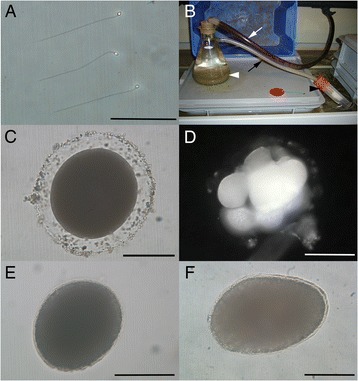Fig. 3.

Reproduction and development of Xenoturbella. a Xenoturbella sperm dissected from an adult specimen. Scale bar: 10 μm. b Setup for collecting Xenoturbella eggs and embryos. Seawater enters the flask (white arrowhead) containing mud and Xenoturbella from the black hose (white arrow). Outflow from the flask passes through another hose (black arrow) and enters a tube with a mesh placed at the end (black arrowhead). This is just an example of many different experimental conditions that have been used, such as different containers, container size, presence/absence of running seawater, presence/absence of mud, and mesh size. c Egg found inside the tube with the mesh in the setup shown in (b). Scale bar: 100 μm. d Cleavage stage embryo, probably at the eight-cell stage. Scale bar: 100 μm. e Swimming stage uniformly ciliated embryo just after hatching, with the anterior to the top right. Scale bar: 100 μm. f Five days after hatching, with the anterior to the left. Scale bar: 100 μm
